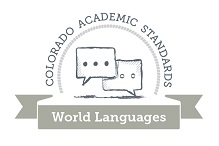You are here
High Impact Instructional Strategies: World Languages
District Sample Curriculum (DSCP): Phase IV High Impact Instructional Strategies
Hello,
I am very proud to present standards-based instructional resources for World Languages. The model lesson is a set of full lesson materials developed to train content area teachers at the 2016 All Students, All Standards Instructional Strategies Summer Institute. The additional sample lesson resources represent the work of a team of Colorado educators to share how they develop their own unique standards-based lessons that employ high-impact instructional strategies. As examples, they are intended to provide support (or conversation/creation starting points) for teachers, schools, and districts as they make their own local decisions around the best instructional plans and practices for all students.
Phase IV of the District Sample Curriculum Project is intended to share just a sampling of lesson planning processes and ideas as a response to requests from local schools and districts asking for more explicit instructional sample ideas. Thank you to the educators that worked diligently to submit their work for this purpose!
Lulu Buck
World Languages Content Specialist
World Languages Instructional Resources
Understanding the Proficiency Scale for Classroom Instruction
The following video segment is a short workshop on how understanding the Proficiency Scale of student language is important to classroom instruction citing the work of Chantal Thomas of Brigham Young University. The proficiency scale will support teachers in knowing appropriate activities and instruction for students.
Teacher handout for "Understanding the Proficiency Scale" (PDF)
Model Lesson
Spanish Levels 1-3: "World Issues Unit" District Sample Curriculum Project. (Leslie Davison of Summit School District)
Lesson Description: Model lesson emphasized on multiple levels of proficiency having multiple instructional strategies. The mini lessons would form an entire unit of instruction. The student audience contained levels of proficiency ranging from Novice-low to Superior levels of language. The model lesson is to engage educators in understanding instruction and identifying proficiency levels and appropriate instruction.
The following 7 video parts are the lesson that was modeled at the ASAS Institute. Each segment is organized by (agenda item and order of the lesson).
- Part 1 - Beginning of the model lesson in building new vocabulary (1000 new words) for students
- Part 2 - Storytelling, (2000 new story) using Google slides. Students create a "choose your own adventure" story
- Part 3 - Reading (3000 let's read)
- Part 4 - Brain Break for students
- Part 5 - Lesson around Palm Oil (4000 the threat)
- Part 6 - Breakout EDU in World Language (5000 a problem)
- Part 7 - Student Reflections on the lesson
Teachers Teaching Teachers, Model Lessons at the Institute
Spanish Lesson #1 - Food
Lesson Description - In this lesson teacher participants were engaged in storytelling. Instructor modeled how to incorporate another language, American Sign Language, during instruction.
Chinese Lesson - Weather and Comparisons
Lesson Description: In this lesson, teacher participants will compare the temperature in the areas they live as well as some cities in China with vocabulary they newly acquired.
German Lesson - Greetings
Lesson Description: In this lesson, teacher participants were given an idea of what the first day of instruction could look like.
Spanish Lesson #2 - Clothing
Lesson Description - In this lesson, teacher participants received an overview of a unit incorporating vocabulary building activities, video and reinforcing language with reading.
French Lesson - Personality Traits
Lesson Description - Beginning of this video captures teachers reflecting on the Spanish Lesson #2. The discussion captures strategies through the reflection process to improve our instruction and future lessons. NOTE: French lesson starts on 13:44 into this video segment. In this lesson, teacher participants role play in a creative dating game skit to learn personality traits.
Sample lessons submitted by World Languages teachers
The lessons below represent some of the approaches teachers used in lesson design. One purpose of the lesson design project was to tap into the questioning and reflective practices that enable deliberate and intentional instructional decisions. We wanted to tap into the metacognitive processes that underlie the decisions teachers make as they plan, deliver, and reflect on their instruction.
Chinese: Calendar and Celebrations Unit (Deling Maxon, Chinese Teacher at Chinook Trail Elementary School)
Lesson Description: In this lesson, students engage in authentic dialogue with classmates about their birthdays and how birthdays are celebrated in traditional and modern Chinese cultures.
- Chinese Calendar and Celebrations Lesson Plan (DOC)
- Chinese Calendar and Celebrations Teacher Reflection (DOC)
Spanish: Clothing Unit (Becky Loftus, Spanish Teacher at Oberon Middle School)
Lesson Description: In this lesson, students can effectively communicate about clothing and shopping in the real world. Students will use practical language to obtain everyday items in the real world.
Chinese: Chinese Moon Festival (Jen Pan, Chinese Teacher at Chinook Train Elementary School)
Lesson Description: In this lesson, students celebrate the Chinese Moon Festival and learn the legend, cultural products, and cultural practices of the Moon Festival. Students engaged in the poetry embedding culture within the language in this lesson.




Connect With Us





